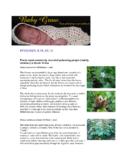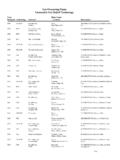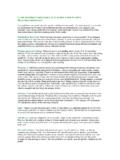Transcription of Basic Techniques for Propagating Plants - …
1 Dr. Sharon M. Douglas Department of Plant Pathology and Ecology The Connecticut Agricultural Experiment Station 123 Huntington Street, P. O. Box 1106. New Haven, CT 06504. Phone: (203) 974-8601. Fax: (203) 974-8502. Founded in 1875 Email: Putting science to work for society Website: Basic Techniques FOR Propagating Plants . Many types of Plants in and around the Techniques : home can easily be propagated using fairly This fact sheet focuses on Techniques for simple, inexpensive procedures. This fact vegetative propagation of Plants . Plants sheet highlights a few of the Basic and most propagated using these methods have the widely applicable Techniques for vegetative same characteristics as the parent or source propagation of Plants . Some of these plant since vegetative material is used and Techniques can be used for houseplants, no genetic recombination is involved.
2 The annual flowers, and bedding Plants , whereas key Techniques for propagation that will be other Techniques are more effective for highlighted are: leaf cuttings, stem woody ornamental trees and shrubs, ground cuttings, simple layering, and air layering. covers, and vines. Although many of the Techniques can be There are many reasons for Propagating used for a range of different types of Plants , Plants . One Basic reason is simply to make it is important to know that some Plants root multiple Plants from a single plant. Another better at a particular stage of growth, at a reason is to make a young attractive plant specific time of year or using a particular from an old, leggy plant. Other reasons are technique . Numerous reference books and to propagate a particular plant because of its experience will help to determine the best unique or attractive features and to time and method to propagate specific propagate Plants for sentimental reasons.
3 Plants . Regardless of the reason for Propagating Plants , there are some Basic factors that are Basic TOOLS AND. useful to ensure success: EQUIPMENT: use only healthy, vigorous source Plants ;. As with any procedure, there are some Basic use the most appropriate method, growth tools and equipment that are necessary in stage, and timing for the plant;. order to complete the job and the following protect propagation material from heat list highlights some necessary and optional and from drying; use the material as items: quickly as possible after it is prepared; pruning shears give newly propagated Plants extra scalpel, sharp knife or razor blade attention and care during their paint brush establishment phase;. wooden matches1 prepare the rooting medium (either a small wooden sticks soil-less potting mix or peat moss and wooden or plastic stakes1 coarse sand); this should be moist but soil-less potting mix or a 1:1 mix of peat not wet; fill the pots with the medium.
4 Moss and clean, coarse sand select and cut healthy leaves with sphagnum moss1 petioles from the source plant using a wire or wire coat hangers sharp, clean knife;. propagation mat (used for bottom heat) trim the base of the petiole but leave tape1 enough to insert into the rooting medium pots or flats of various sizes without the leaf touching the surface;. rooting hormone2 dip or lightly dust the cut surface with clear plastic bags and plastic wrap rooting hormone (this is optional, depending on the plant); in order to 1. used specifically for air layering and/or avoid contaminating the hormone, put a simple layering. small quantity in a cup rather than 2. rooting hormone is usually sold as indole sticking the cutting into the original butyric acid (IBA) and is available in many container;. formulations and concentrations; for Plants make a few planting holes in the rooting that are readily propagated by vegetative medium with a small, clean stick.
5 Methods, use of hormones promotes more gently insert each leaf cutting into a hole root growth in a shorter period of time; for so that the leaf is just above the rooting Plants that are not easily propagated by medium; carefully firm the medium these methods, rooting hormones will not around each cutting with your fingers help with root development. but avoid injury to the petioles;. place a wire frame over the pot or flat;. LEAF CUTTINGS: put the container into a clear plastic bag A number of Plants will readily produce new making certain that the frame is Plants from leaf cuttings. Although there is supporting the plastic bag so the plant no dependable way to distinguish these material is not touching the bag; this Plants from others, most Plants that root creates a mini-moist chamber to keep successfully from leaf cuttings have thick, moisture around the leaves as they root.
6 Fleshy leaves which often grow in rosettes. place the chamber in a warm location These include many of the common out of direct sunlight! a propagation houseplants such as gloxinia, African violet, mat as a source of bottom-heat is helpful begonia, and peperomia. (Refer to Figure but not necessary;. 1.) occasionally inspect the pot for Procedure- condensation and add water as necessary the best time to start leaf cuttings is to keep the potting medium moist but when the Plants are in a strong growth not wet;. phase, usually from early summer to after 3-5 weeks (depending upon the early fall; plant being propagated), roots should select a pot or flat of the appropriate size have started to form;. for the number of leaf cuttings that you when Plants have developed a sufficient will be rooting; root system, gradually harden-off the Basic Techniques for Propagating Plants S.
7 M. Douglas 2. The Connecticut Agricultural Experiment Station ( ). new Plants by opening the bag and increasing light levels;. place the newly rooted Plants into individual pots using care to avoid injury to the new roots. Figure 2. Steps in Propagating by stem cuttings. Herbaceous and Softwood Stem Cuttings These types of cuttings are appropriate for many popular houseplants such as Figure 1. Steps in taking leaf cuttings. philodendron, Christmas and Thanksgiving cactus, jade, and coleus, many annual or STEM CUTTINGS: bedding Plants such as impatiens and This technique is probably the most versatile geranium, popular ground covers such as of all methods used for vegetative pachysandra and English ivy, and woody propagation. It can be used for both ornamentals such as magnolia and maple. herbaceous and woody material. Procedure- Herbaceous stem cuttings can be made these cuttings can be taken at the time from houseplants, annual flowers and appropriate for the particular plant to be bedding Plants , ground covers, and some propagated ( , for houseplants or perennials.)
8 Stem cuttings from woody bedding Plants this is when new shoots ornamentals can be taken at different stages appear in spring; for woody Plants it is of development and are categorized as when the new shoots have expanded and softwood, semi-hardwood, and hardwood are still tender in late spring or summer);. cuttings. Softwood stem cuttings are taken select a pot or flat of the appropriate size in late spring or early summer and consist of for the number of cuttings that you will tender shoots of current season growth. be rooting;. Semi-hardwood stem cuttings are taken prepare the rooting medium (either a from mid- to late-summer and consist of soil-less potting mix or peat moss and current season growth that is firm and has coarse sand); this should be moist but begun to form woody tissues. Hardwood not wet; fill the pots with the medium.
9 Stem cuttings are taken in late fall or winter select and cut terminal shoots and consist of woody stems that have just (preferably not in flower) from the completed their first season of growth. For source plant using a sharp, clean knife or deciduous Plants , these are taken after the pruning shear; the length of the cutting Plants have dropped their leaves. (Refer to is determined by the source plant Figure 2.) (cuttings usually vary from 2-8 inches in length);. Basic Techniques for Propagating Plants S. M. Douglas 3. The Connecticut Agricultural Experiment Station ( ). remove the leaves near the cut end the bag and exposing the cuttings to making certain that some leaves (3-8) increasing light levels;. remain on the cutting; if the cutting is in place the newly rooted Plants into flower, carefully pinch off the flowers individual pots using care to avoid injury and flower buds; to the new roots.
10 Use a clean, razor blade or scalpel to new cuttings will require extra care remove a thin slice of tissue about - 1 during the establishment phase. inch long on two opposite sides of the cut end or base of the cutting; this Semi-hardwood Cuttings provides a surface for root development; Follow the same Techniques for herbaceous lightly dust the cut sides of the cutting or softwood cuttings but select cuttings at with rooting hormone, as necessary; in the appropriate stage of growth ( , mid- to order to avoid contaminating the late-summer). These types of cuttings are hormone, put a small quantity in a cup appropriate for woody ornamentals such as rather than sticking the cutting into the azalea, rhododendron, butterfly bush, rose, original container; and euonymus. stick the cuttings into the pots or flats of prepared rooting medium about one- Hardwood Cuttings third to one-half of the total length of the Follow the same Techniques for herbaceous cutting; carefully firm the medium or softwood cuttings but select cuttings at around each cutting with your fingers the appropriate stage of growth ( , late but avoid injury to the stem; fall or winter).















